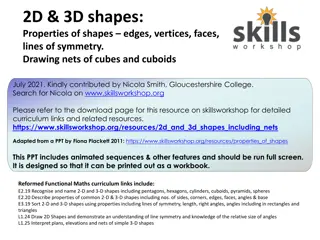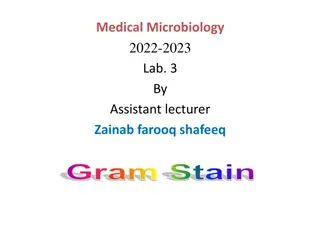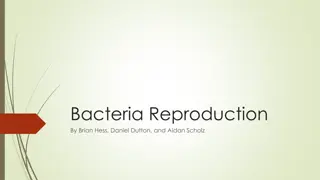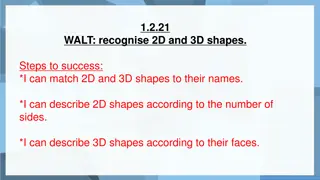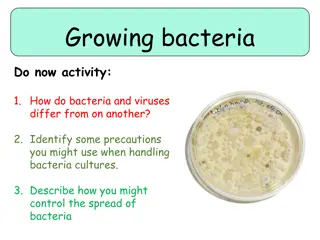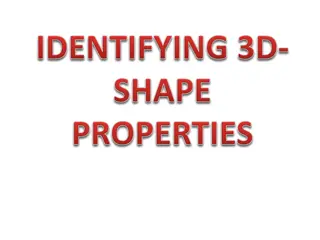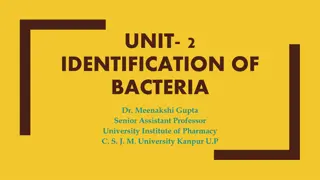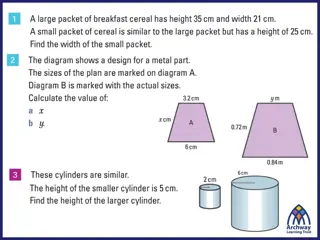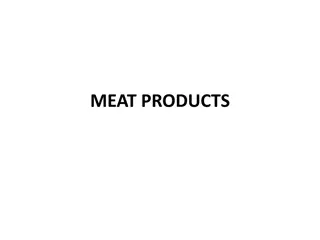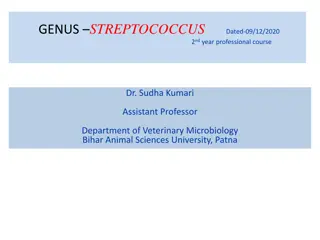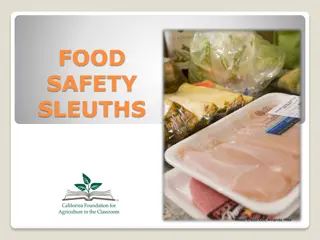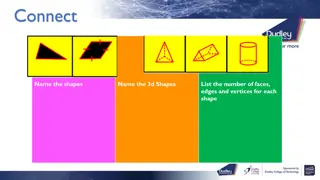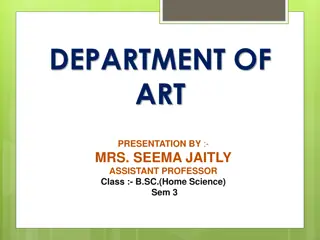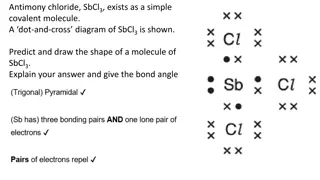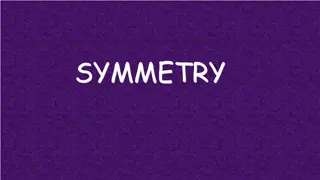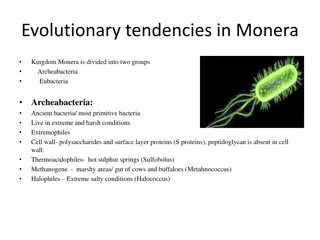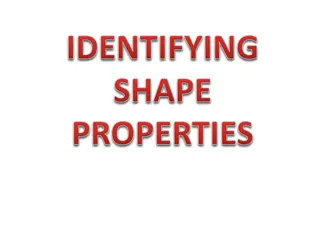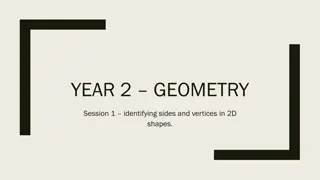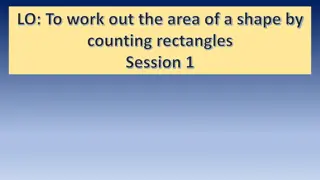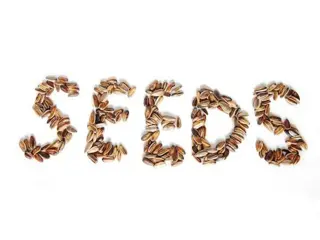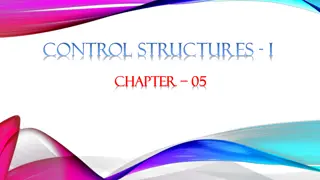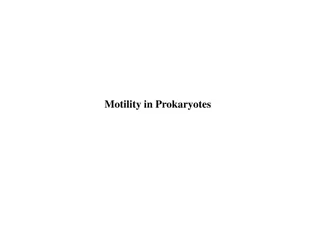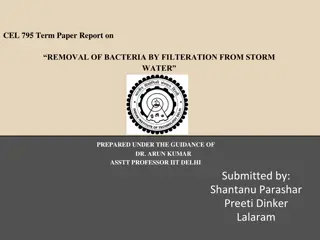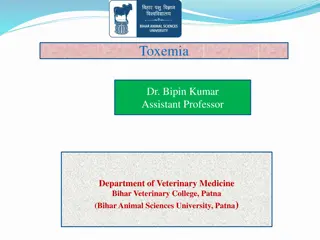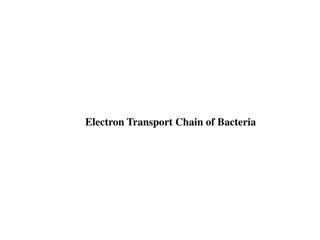Exploring the Fascinating World of Bacteria: Types, Shapes, and Structures
Delve into the diverse characteristics of bacteria, from their food sources to shapes and major cell structures. Discover how bacteria play a crucial role in various environments, from soil to the human body.
Download Presentation

Please find below an Image/Link to download the presentation.
The content on the website is provided AS IS for your information and personal use only. It may not be sold, licensed, or shared on other websites without obtaining consent from the author. Download presentation by click this link. If you encounter any issues during the download, it is possible that the publisher has removed the file from their server.
E N D
Presentation Transcript
Introduction to Bacteria 2 TYPES OF BACTERIA: Bacteria -Get food from an outside source Blue-green Bacteria -Make their own food 1
BACTERIA Bacteria - small one celled monerans Bacteria like a warm, dark, and moist environment They are found almost everywhere: -water -soil -skin -on most objects -air -food -inside the body 2
3 Shapes of Bacteria Bacteria are classified by shape into 3 groups: Spiral: spirilla rod-shaped: bacilli, bacillus Round: cocci 3
3 Shapes of Bacteria Bacillus anthracis (bacillus) Neisseria meningitidis (coccus) Leptospira interrogans (spirilla) 4
7 Major Structures of a Bacteria Cell Capsule Cell wall Ribosomes Nucleoid Flagella Pilli Cytoplasm 5
7 Major Structures of a Bacteria Cell Capsule keeps the cell from drying out and helps it stick to food or other cells 6
7 Major Structures of a Bacteria Cell Cell wall Thick outer covering that maintains the overall shape of the bacterial cell 7
7 Major Structures of a Bacteria Cell Ribosomes cell part where proteins are made Ribosomes give the cytoplasm of bacteria a granular appearance in electron micrographs 8
7 Major Structures of a Bacteria Cell Nucleoid a ring made up of DNA 9
7 Major Structures of a Bacteria Cell Flagella a whip-like tail that some bacteria have for locomotion 10
7 Major Structures of a Bacteria Cell Amimation of E.coli 11
7 Major Structures of a Bacteria Cell Pilli hollow hair-like structures made of protein allows bacteria to attach to other cells. Pilli-singular Pillus-plural 12
7 Major Structures of a Bacteria Cell Cytoplasm clear jelly-like material that makes up most of the cell 13
Reproduction of Bacteria Binary Fission- the process of one organism dividing into two organisms Fission is a type of asexual reproduction Asexual reproduction- reproduction of a living thing from only one parent How?... The one main (circular) chromosome makes a copy of itself Then it divides into two 14
Reproduction of Bacteria BINARY FISSION Completed Bacteria dividing 15
Reproduction of Bacteria The time of reproduction depends on how desirable the conditions are Bacteria can rapidly reproduce themselves in warm, dark, and moist conditions Some can reproduce every 20 minutes (one bacteria could be an ancestor to one million bacteria in six hours) 16
Bacterial Cell & Nucleiod DNA Ring DNA replication Cell wall synthesis Cell separation 17
Bacteria Survival Endospore- a thick celled structure that forms inside the cell they are the major cause of food poisoning allows the bacteria to survive for many years they can withstand boiling, freezing, and extremely dry conditions it encloses all the nuclear materials and some cytoplasm 18
Bacteria Survival Bacillus subtilis Endospore-the black section in the middle highly resistant structures can withstand radiation, UV light, and boiling at 120oC for 15 minutes. 19
Bacteria Survival Food sources parasites bacteria that feed on living things saprophytes use dead materials for food (exclusively) decomposers get food from breaking down dead matter into simple chemicals important- because they send minerals and other materials back into the soil so other organisms can use them 20
Harmful Bacteria some bacteria cause diseases Animals can pass diseases to humans Communicable Disease Disease passed from one organism to another This can happen in several ways: Air Touching clothing, food, silverware, or toothbrush Drinking water that contains bacteria 21
Harmful Bacteria Human tooth with accumulation of bacterial plaque (smooth areas) and calcified tartar (rough areas) 22
Helpful Bacteria Decomposers help recycle nutrients into the soil for other organisms to grow Bacteria grow in the stomach of a cow to break down grass and hay Most are used to make antibiotics Some bacteria help make insulin Used to make industrial chemicals 23
Helpful Bacteria E.coli on small intestines 24
Helpful Bacteria Used to treat sewage Organic waste is consumed by the bacteria, used as nutrients by the bacteria, and is no longer present to produce odors, sludge, pollution, or unsightly mess. foods like yogurt, cottage & Swiss cheese, sour cream, buttermilk are made from bacteria that grows in milk 25
Controlling Bacteria 3 ways to control bacteria: 1) Canning- the process of sealing food in airtight cans or jars after killing bacteria endospores are killed during this process 2) Pasteurization- process of heating milk to kill harmful bacteria 3) Dehydration- removing water from food Bacteria can t grow when H2O is removed example: uncooked noodles & cold cereal 26
Controlling Bacteria Antiseptic vs. Disinfectants Antiseptic- chemicals that kill bacteria on living things means against infection Examples: iodine, hydrogen peroxide, alcohol, soap, mouthwash Disinfectants- stronger chemicals that destroy bacteria on objects or nonliving things 27
BLUE-GREEN BACTERIA Autotrophs make their own food through photosynthesis larger than most bacterial cells commonly grow on water and surfaces that stay wet such as rivers, creeks and dams Some live in salt water, snow, and acid water of hot springs food source for animals that live in the water 28
BLUE-GREEN BACTERIA can be toxic to humans and animals Blooms- occur when the bacteria multiplies in great numbers and form scum on the top of the water BlueGreen-Algae 29
Lake Champlain BlueGreen-Algae 30
Bacillus anthracis - rod, vegetative stage prokaryote (bacterium) Image Number: 21185A 33
Neisseria meningitidis - coccus prokaryote (bacterium) Image Number: 97214E 34
Leptospira interrogans - spiral shaped prokaryote (spirochete) 35
Strep animation http://www.hybridmedicalanimati on.com/pages/jjani_qt/strep_pne umo_qt.html Ecoli movement animatoin http://www.hybridmedicalanimati on.com/pages/jjani_qt/ecoli_qt.h tml 36
Ecoli movement animatoin http://www.hybridmedicalanimation.com/pa ges/jjani_qt/ecoli_qt.html 37
HIV movie http://www-micro.msb.le.ac.uk/Video/HIV.mov 38


